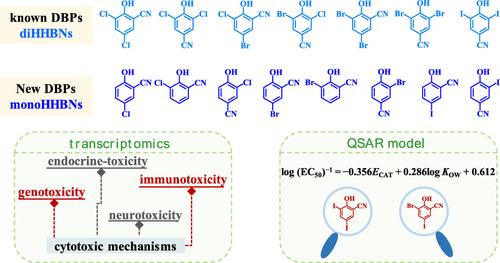当前位置:
X-MOL 学术
›
Environ. Sci. Technol.
›
论文详情
Our official English website, www.x-mol.net, welcomes your
feedback! (Note: you will need to create a separate account there.)
New Species and Cytotoxicity Mechanism of Halohydroxybenzonitrile Disinfection Byproducts in Drinking Water
Environmental Science & Technology ( IF 10.8 ) Pub Date : 2024-08-21 , DOI: 10.1021/acs.est.4c06163 Shaoyang Hu 1 , Xiangxiang Li 1 , Guangzhao Li 1 , Zhigang Li 2 , Falin He 1 , Guang Tian 1 , Xingchen Zhao 1 , Rutao Liu 1
Environmental Science & Technology ( IF 10.8 ) Pub Date : 2024-08-21 , DOI: 10.1021/acs.est.4c06163 Shaoyang Hu 1 , Xiangxiang Li 1 , Guangzhao Li 1 , Zhigang Li 2 , Falin He 1 , Guang Tian 1 , Xingchen Zhao 1 , Rutao Liu 1
Affiliation

|
Recently, seven dihalohydroxybenzonitriles (diHHBNs) have been determined as concerning nitrogenous aromatic disinfection byproducts (DBPs) in drinking water. Herein, eight new monohalohydroxybenzonitriles (monoHHBNs), including 3-chloro-2-hydroxybenzonitrile, 5-chloro-2-hydroxybenzonitrile, 3-chloro-4-hydroxybenzonitrile, 3-bromo-2-hydroxybenzonitrile, 5-bromo-2-hydroxybenzonitrile, 3-bromo-4-hydroxybenzonitrile, 5-iodo-2-hydroxybenzonitrile, and 3-iodo-4-hydroxybenzonitrile, were detected and identified in drinking water for the first time. Thereafter, the relative concentration–cytotoxicity contribution of each HHBN was calculated based on the acquired occurrence level and cytotoxicity data in this study, the genome-scale cytotoxicity mechanism was explored, and a quantitative structure–activity relationship (QSAR) model was developed. Results indicated that new monoHHBNs were present in drinking water at concentrations of 0.04–1.83 ng/L and exhibited higher cytotoxicity than some other monohalogenated aromatic DBPs. Notably, monoHHBNs showed concentration–cytotoxicity contribution comparable to diHHBNs, which have been previously identified as potential toxicity drivers in drinking water. Transcriptomic analysis revealed immunotoxicity and genotoxicity as dominant cytotoxicity mechanisms for HHBNs in Chinese hamster ovary (CHO-K1) cells, with potential carcinogenic effects. The QSAR model suggested oxidative stress and cellular uptake efficiency as important factors for their cytotoxicity, highlighting the importance of potential iodinated HHBNs in drinking water, such as 3,5-diiodo-2-hydroxybenzonitrile, for future studies. These findings are meaningful for better understanding the health risk and toxicological significance of HHBNs in drinking water.
更新日期:2024-08-21






























 京公网安备 11010802027423号
京公网安备 11010802027423号